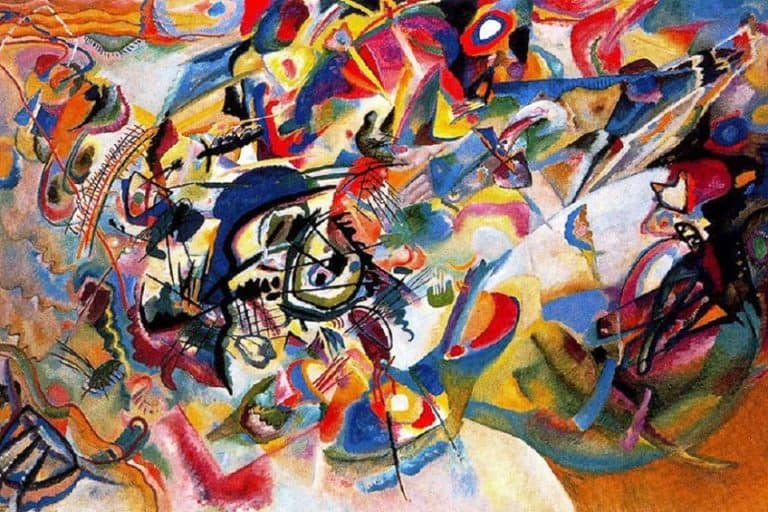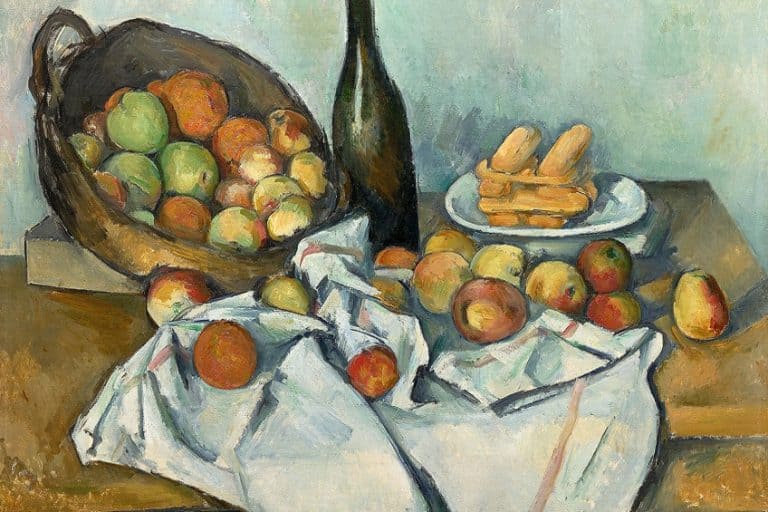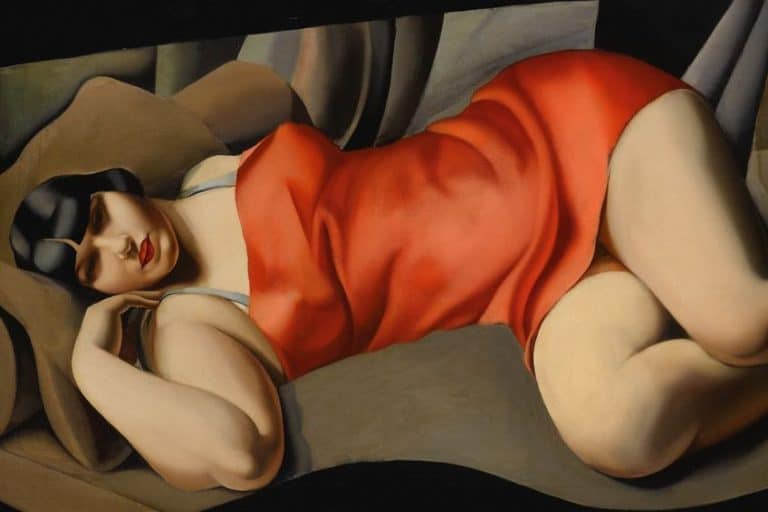Roman Paintings – Exploring the Various Paintings of Ancient Rome
Ancient Roman artwork was traditionally viewed as being nothing more than a copy of the Greek style, however, more recent re-analyses of Roman paintings and sculptures have revealed how stylistically eclectic their influences really were. Modern scholars point out the influence from not only Greek models, but also the native Italic, the Etruscan culture, and even the Egyptian culture.
A Brief Introduction to Ancient Roman Artwork
The art of ancient Rome has a long and interesting history. Although the Romans were at first heavily influenced by the Greeks, they soon developed their own unique techniques and styles. Let us take a brief look at the history of Roman art before looking at some famous paintings from the region.
The Greek Influence
The artists of ancient Rome are mostly known for the immense quality and quantity of their Greek-inspired sculptures. Made from the 1st century onward, they have survived up until the present day and show great skill and craftsmanship. Very few examples of Roman paintings still exist, however, except for a few very notable exceptions such as the Roman frescoes and Pompeii wall paintings.
Many of the techniques used in ancient Roman artwork such as mosaics, free-standing sculpture, Roman drawings, vase art, and jewelry design can be traced back to their admiration for the classic Greek artists.

However, the emerging Roman empires were much larger than their Greek predecessors, and because of the multitude of cultures that were continuously incorporated by the empire, the sculpture and paintings of ancient Rome reflect this assimilation of styles from other cultures.
Paintings of Ancient Rome
It is believed that at one time Roman drawings and paintings of ancient Rome were as common as their sculptures, but unfortunately, we now only have a few remaining examples of the documented ancient Roman artworks, with most of these coming from the last years of that era. The most well-known of these remaining splendors are the Roman wall paintings from Pompeii, which portray the lives of the locals through Roman Fresco art before the eruption of Mount Vesuvius in 79 AD.

The catacombs of Rome have revealed a substantial body of Roman paintings created from the beginning of the 3rd century and ending around 400 AD. There are also Roman wall paintings from other highly decorated rooms in the empire that have helped scholars begin to fill in the gaps of ancient Roman artwork, such as the bust portraits and the Fayum mummy portraits of Roman Egypt.
Although displaying a distinctly Egyptian aesthetic, many of these examples are said to show a Roman style of portrait painting that doesn’t exist anywhere else today.
The Themes and Subjects of Roman Paintings
The themes in Roman paintings are wide in variety, offering paintings of landscapes, portraits, mythological animals, real animals, still-lifes, and everyday scenes. Scenes of rural landscapes, shepherds, temples, and herds were prominent during the Hellenistic period, evoking the pleasures of the rural countryside. Landscapes were the largest artistic development compared to the Greek arts and showed a great understanding of mathematical perspective.

Famous Roman Frescos, Mosaics, and Roman Wall Paintings
Roman art has mostly survived in the form of objects that are made from time-resistant materials such as sculptures and mosaics. Very few intact examples remain of Roman paintings and Roman drawings due to the temporary nature of the medium. Today, we will look at the best remaining examples of ancient Roman artwork and Roman wall paintings.
Cubiculum From the Villa of P. Fannius Synistor at Boscoreale
| Date | ca. 50 – 40 B.C. |
| Medium | Roman Fresco |
| Dimensions | 265.4 cm× 334 cm × 583.9 cm |
| Period | Late Republic |
This highly ornate room originally served as a bedroom before being buried when Mount Vesuvius erupted in 79 AD. The back wall depicts a rocky environment with a railing supported by balusters and a garden landscape. There is also a small cave that is sheltering a water fountain and a little figure of Hekate. Between a couple of columns, in the center of the wall, a balcony wall has been depicted, on which a golden landscape has been painted. On top of the golden parapet is a bowl of fruit.

The walls on either side of the room are symmetrical, with each wall being further subdivided into four sections by a rectangular column projecting from the wall that defines the couch area. Each section depicts a different scene, such as a painting of an enclosed courtyard, from which one can glimpse statues, flowers, vegetation, as well as domed circular rotundas.
These typically beautiful landscape scenes alternate between townscape paintings of ancient Rome throughout the ornately decorated room.
Wall Painting From Room H of the Villa of P. Fannius Synistor at Boscoreale
| Date | ca. 50 – 40 B.C. |
| Medium | Roman Fresco |
| Dimensions | 186.7 cm x 186.7cm |
| Period | Late Republic |
This painting depicts a seated woman playing a traditional musical instrument known as a kithara. It is a Roman fresco painted in Room H of the Villa at Boscoreale, which was either used as a room for social gatherings or a dining room. Each Pompeii wall painting found in this room was derived from the large-scale paintings of Greek tradition known as megalographia. In this Roman fresco, a voluptuous woman robed in white himation and purple chiton is depicted sitting on a chair, playing a kithara.
She is bejeweled with earrings, a bracelet, a central medallion, and a headband, all of which are made from gold.

Standing behind the woman wearing a chiton with no sleeves is a young girl. She is also adorned with golden jewelry, and both are posed staring directly at the viewer. Recently, scholars have suggested that the woman and young girl perhaps represent a princess or queen from Macedonia and her younger sibling or offspring. This impression of royalty is due to the use of ornate golden jewelry, as well as the throne-like chair and highly decorated musical instruments.
Despite not knowing who exactly the subjects of this painting represent, it is still appreciated as an excellent example of Hellenistic art.
Perseus and Andromeda in Landscape From the Imperial Villa at Boscotrecase
| Date | Last decade of the 1st century B.C. |
| Medium | Roman Fresco |
| Dimensions | 159 cm x 118.7 cm |
| Period | Augustan |
This Roman fresco can be found in the imperial villa of Agrippa Potumus at Boscotrecase. It portrays two events from the myth of Andromeda and Perseus. In this scene, Andromeda is about to be rescued by Perseus from the snake-like sea monster known as Ketos. Andromeda stands in the center of the panel, with her arms outstretched as the brilliant green and blue creature stretches its gigantic jaws at Andromeda from the bottom left corner of the canvas.
One of her hands is placed gracefully on a rock, while the other seems to be chained to the crag.

With wings on his shoes and a lyre in hand, Perseus flies towards Andromeda from the left of the scene. On the right of the hilly crag is a depiction of Perseus meeting with Andromeda’s grandfather, an allusion to the mythical happy ending of the tale. These themes of love and the sea are found in another work of art in the same room at the villa, the Polyphemus and Galatea painting. Both paintings have the same green-blue background in each, bringing to the room a sense of coolness.
West Wall of Room L of the Villa of P. Fannius Synistor at Boscoreale
| Date | Ca. 50 – 40 BC |
| Medium | Roman Wall Painting |
| Dimensions | 195.6 cm x 271.8 cm |
| Period | Late Republican |
This large fresco can be found on the west wall of the villa’s peristyle. It is believed that a bull’s head once occupied the center of the wall, but now, a painted version is depicted with a basket hanging from a chord in its mouth. Inside the basket is a bed of ivory, out of which a snake can be seen crawling.
The painting depicts a wall of masonry that has been simulated with paint.

Five red slabs are separated by painted golden pillars. Along the wall runs a garland of leaves and fruits from which a satyr mask and cymbal are suspended. Above the garland are alternating gold and green blocks that feature entablature consisting of a purple-colored frieze ornately illustrated with brackets, made to look like snakes with interlaced tails.
Alexander Mosaic From the House of Faun
| Date | Ca. 100 BC |
| Medium | Mosaic |
| Dimensions | 272 cm × 513 cm |
| Location | National Archaeological Museum, Naples |
This Roman mosaic was originally from the floor of the House of Faun in Pompeii. It is an imitation copy of Apelle or Philoxenus of Eretria’s painting from the 4th century BC. This Roman artwork displays a combination of various artistic traditions such as Roman, Hellenistic, and Italic. This mosaic depicts many figures engaged in a battle spread over a large area. Alexander is portrayed in profile view, positioned in the left half of the composition. In his hand is a javelin or spear.
Typical Roman facial features can be made out in Alexander’s face; he is depicted with a stoic expression and a Roman nose.
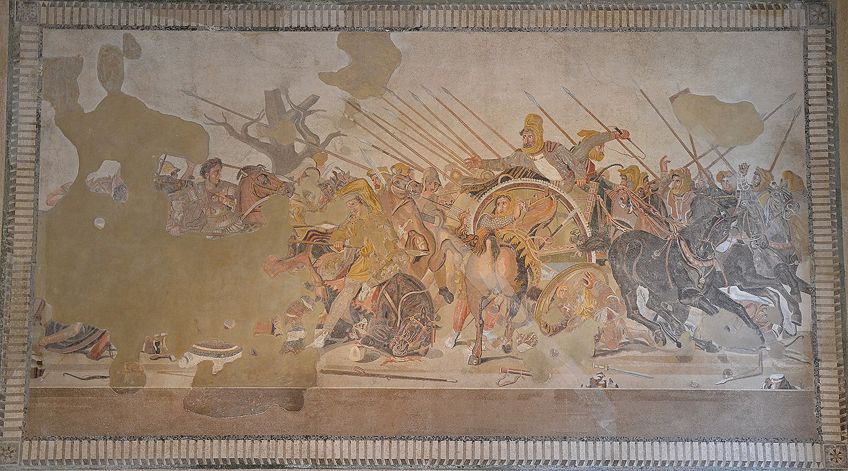
Alexander has been illustrated sporting an armored breastplate with the head of the mythological Medusa. Most of us know the story of Medusa: In Greek mythology, her head had the power to turn people into stone. Divine birth is another interpretation of the symbolic use of her head in this composition. Alexander’s face is not covered by any sort of helmet to be instantly recognizable from his portrayal, with his determined gaze fixed on the Persian King, Darius. In the right half of the mosaic, the space is mostly taken up by Darius and his charioteer.
Famous Paintings Based on Ancient Roman Mythology
Roman mythological art encompasses a group of traditional stories focusing on the religious inclinations and ancient origins of the Roman Empire. These stories reflected moral values and politics and therefore served an important social purpose at the time. Common themes were religious rituals and mythical heroes. Let us take a look at some famous paintings based on Roman mythology
Venus and Mars (1483) by Sandro Botticelli
| Artist | Sandro Botticelli |
| Year | 1483 |
| Medium | Tempera on Panel |
| Dimensions | 69 cm x 173.5 cm |
Born in 1445, Sandro Botticelli hailed from Florence. Botticelli was not by any means an ordinary painter of his time but was considered an eminent figure of the Italian Early Renaissance period. He was most well-known for his interpretations of religious figures as well as his paintings of mythological tales. Botticelli is highly revered for his works Primavera (1477-1482) and The Birth of Venus (1485-1486).
Although scholars are unsure of the exact date of production, “Venus and Mars” is believed to have been painted sometime between 1483 and 1485.

The painting portrays the Roman mythical figures Mars, the god of war, and Venus, the goddess of love, enjoying a leisurely moment in the forest, reclining on the ground surrounded by mischievous and playful satyrs. Scholars have suggested that it depicts the celebration of a wedding and that it is an allegory for valor and beauty. This painting is generally interpreted as a representation of sensuous and divine love. Since 1874, it has been housed at the National Gallery.
Parnassus (1497) by Andrea Mantegna
| Artist | Andrea Mantegna |
| Year | 1497 |
| Medium | Tempera on Canvas |
| Dimensions | 160 cm x 192 cm |
Andrea Mantegna was an Italian Renaissance painter and a student of Roman Archeology. He was born in Isola di Carturo in 1431 and was the son-in-law of Renaissance artist Jacopo Bellini. Parnassus was created by Mantegna in 1497. Situated in the Ducal Palace of Mantua, it was made for Isabella d’Este as part of a cabinet for her studio. Duke Charles I of Mantua then gave the painting along with others in the cabinet to Cardinal Richelieu in 1627.
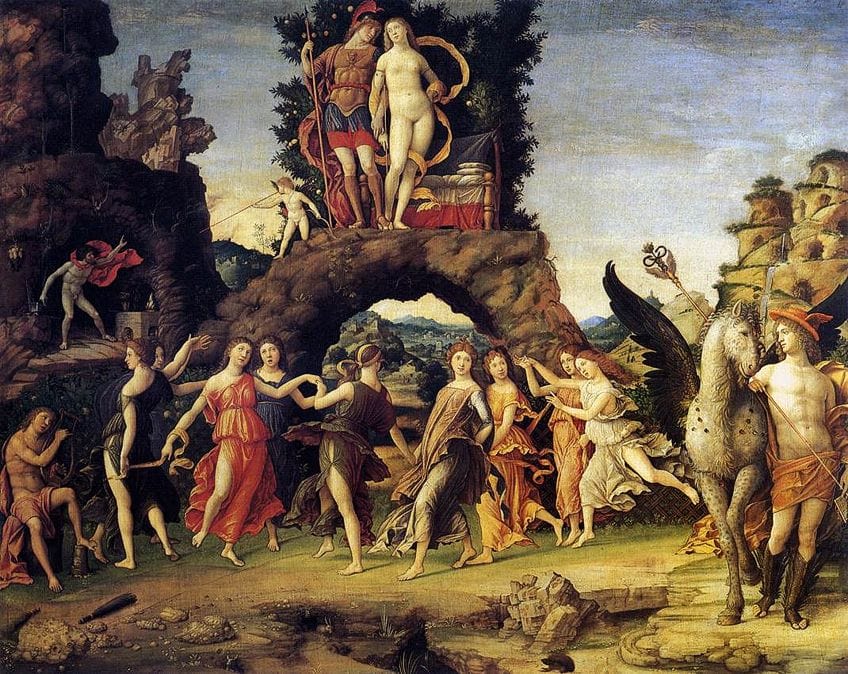
Through that succession of hands, this painting then found its way into the royal collections belonging to Louis XIV of France, before eventually being housed at the Louvre Museum. It was the court’s poet Paride da Ceresara who had suggested the theme for the painting.
A poem by Battista Fiera in the late 15th century was described as representing the Mount of Parnassus, including the symbolic depiction of Francesco II Gonzaga as Mars and Isabella as Venus.
Wedding Banquet of Cupid and Psyche (1517) by Raphael
| Artist | Raphael |
| Year | 1517 |
| Medium | Fresco |
| Location | Villa Farnesina, Rome |
Raphael was an Italian Renaissance painter born in Rome in 1520. His artwork is highly revered by scholars for its proficiency in composition and lucidity of form. Along with Leonardo da Vinci and Michaelangelo, he forms part of the trinity of masters of that era. Despite an early death at the age of 37, he left behind a considerably large body of work. One of these paintings was the Wedding Banquet of Cupid and Psyche, a gorgeous fresco painted in the Villa Farnesina.

In the vault panel, the story is illustrated in two broad format paintings. Raphael has placed the scenes in painted tapestries that appear to be hanging between the garlands. On the right side of the panel, Raphael has portrayed the council of gods. In the scene, Jupiter has decided to accept Psyche and at that point, the drink of mortality is given to her by Mercury. On the left side panel, we can then see the painting of the actual wedding celebration.
Raphael has depicted the secret communal life of the gods in a manner that reflects their all too human aspects despite their divinity.
Amor Vincit Omnia (1601) by Caravaggio
| Artist | Caravaggio |
| Year | 1601 |
| Medium | Oil on Canvas |
| Dimensions | 156.5 cm x 113.3 cm |
Michelangelo Merisi da Caravaggio, better known as just Caravaggio, was an Italian Baroque painter born in Milan on the 29th of September, 1571. Besides spending his final four years living between Sicily, Malta, and Naples, he spent most of his life working as a painter in Rome. His work had a huge influence in the formative days of the Baroque movement, especially for his dramatic use of lighting, as well as his realistic portrayal of the physical and emotional aspects of the human state.
He is most known for his unique interpretations of classical themes and technical virtuosity, as can be seen in this painting.

Amor Vincit Omnia means “victorious Cupid”, or “love conquers all”. The painting depicts the Roman Cupid or winged Amor. The mythological figure stands in the middle of symbols of human endeavor such as a manuscript and pen, armor, compasses, and musical instruments. In Virgil’s Eclogues X.69, he wrote “let us all yield to love, for love conquers all”, and this painting is meant to be an illustrated form of the figurative interpretation of love as Cupid.
Scholars have suggested that the painting is meant to represent the home of Marchese-Vincenzo Giustiniani, a nobleman who loved painting and music, and whose family ruled the island of Chios. Giustiniani was said to be a scholar of astronomy and a constructor.
The Feast of Venus (1636) by Peter Paul Rubens
| Artist | Peter Paul Rubens |
| Year | 1636 |
| Medium | Oil on Canvas |
| Dimensions | 2,170 mm x 3,500 mm |
Peter Paul Rubens was a Flemish artist born in Siegen, Nassau-Dillenburg, Holy Roman Empire in 1577. His hugely influential Baroque style emphasized movement, sensuality, and color. He is regarded as the most influential figure of the Flemish art movement and was a painter of portraits, landscapes, altarpieces, and historical paintings of mythological subjects. Many of his large-scale paintings were commissioned by the courts of Europe.
“The Feast of Venus” is a depiction of a traditional Roman celebration called Veneralia, which was a festival in honor of Venus Verticordia.

Originally mentioned by Philostratus of Lemnos, a Greek philosophist, Titian was inspired to write the book The Worship of Venus, which in turn inspired Rubens to create this painting. The book contained various descriptions of ancient artwork which inspired Rubens, as well as one of the books of Ovid’s Fasti. If traveling to Vienna, one can view The Feast of Venus where it is now housed at the Kunsthistorisches Museum. The painting portrays cherub-like children dancing around a central statue in a beautiful Eden-like landscape.
Saturn Devouring His Son (1819) by Francisco Goya
| Artist | Francisco Goya |
| Year | 1819 |
| Medium | Oil on Canvas |
| Dimensions | 143 cm × 81 cm |
Francisco Goya was a Spanish painter and printmaker known for his work in the Romanticism movement. Regarded as one of the most prominent Spanish artists of the late 18th century, his paintings were appreciated for their reflection of historical upheavals and contemporary events.
Often referred to as the Last Old Master, this composition was made during the final phase of his career, as he became increasingly overwhelmed by the horrific turmoil of the Napoleonic Wars that swept through his beloved country.

Saturn Devouring His Son is a portrayal of the Titan Cronus. Originally a Greek myth, the name had been Romanized to Saturn in this region and era. In the myth, Saturn is afraid of one day being overthrown by one of his offspring, so shortly after they are born, he eats them. This painting was installed on the walls of his house and was part of a series entitled The Black Paintings. Posthumously, the paintings were removed and then transferred onto canvas. These artworks are now exhibited at the Museo del Prado in Madrid.
Mars Being Disarmed by Venus (1824) by Jacques-Louis David
| Artist | Jacques-Louis David |
| Year | 1824 |
| Medium | Oil on Canvas |
| Dimensions | 308 cm x 265 cm |
Jacques-Louis David was a master of historical painting in the Neoclassical style from France and was considered a trendsetter of his time. Initially a supporter of the French Revolution, he became affiliated with Napoleon after the shifting politics of the late XVIII century. During this period, he started promoting the Empire style, which would become popular for some time.
It was while Jacques-Loyd David was living in Brussels in 1824 that he produced “Mars Being Disarmed by Venus”. David passed away in an accident a year after painting this masterpiece.

In this large painting Venus, the goddess of love, is seen helped by the three graces and Cupid as they remove weapons and armor from Mars, the god of war. He seems to be overpowered by the goddess and reclines in relaxation, unable to resist her. David was said to have been inspired by the performers he had seen at the Théâtre de la Monnaie. The painting was later sent to an exhibition in Paris where it was greatly admired and received critical acclaim for its powerful display of mastery of the craft. It has been on permanent exhibition at the Royal Museums of Fine Arts of Belgium since 2002.
Paintings of Ancient Rome
Rome was a powerful political region, as well as a hub of art. Many artists moved to Rome to learn and work, and many were commissioned to create beautiful artworks of the region. In this section, we will look at a few examples of artists who painted the scenery of ancient Roman life.
Ancient Rome (1757) by Giovanni Paolo Panini
| Artist | Giovanni Paolo Panini |
| Year | 1757 |
| Medium | Oil on Canvas |
| Location | Staatsgalerie, Stuttgart |
Giovanni Paolo Panini was born in 1691 in Piacenza, Duchy of Parma, in the Holy Roman Empire. He was greatly admired for his vistas of Rome, where he took interest in the antiquated architecture of the city. He was well known for his Vedute (paintings containing galleries of pictures of Rome). Many of his works contain a mixture of real and fanciful architecture, a style known as capricci.
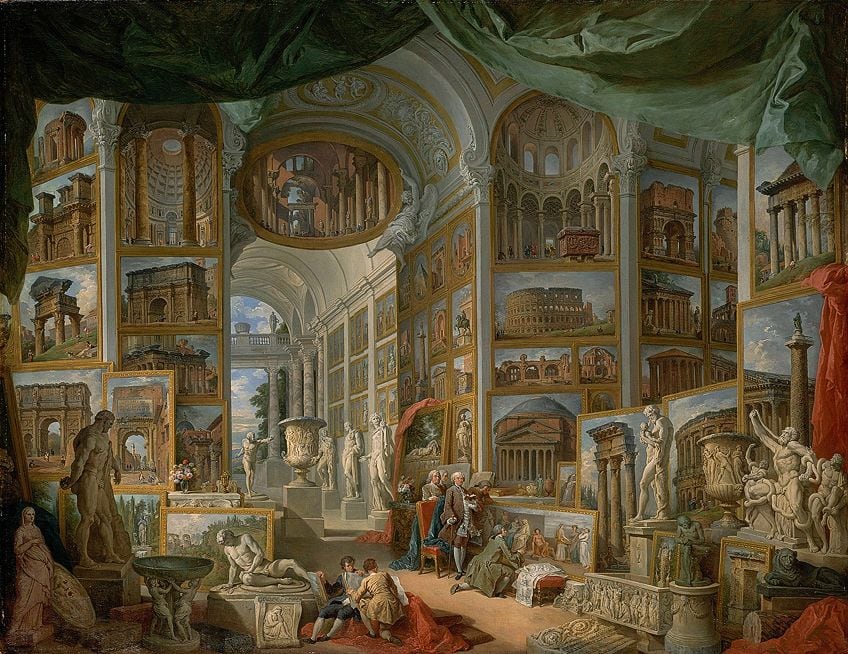
Ancient Rome was a name given to three separate but nearly identical works created by Panini. They were originally created in the 1750s as pendants for the Comte de Stainville, his patron. The pendants illustrated many of the finest sculptures and architectural sites from ancient Rome such as the Farnese Hercules, the Colosseum, the Apollo Belvedere, Trajan’s Column, and the Pantheon.
The artist is portrayed in the painting as well, behind Stainville’s chair, as is the patron, who is painted in a standing pose, holding a book.
The Obelisk (1783) by Hubert Robert
| Artist | Hubert Robert |
| Year | 1783 |
| Medium | Oil on Canvas |
| Location | Art Institute of Chicago |
Hubert Robert was born in 1733 in Paris, France. He was a French painter from the Romanticism school. He was most noted for his landscape and capriccio style of painting, creating semi-fictitious scenes of Roman and French ruins. Although originally from Paris, he spent 11 years in Rome. He first studied at the French Academy in Rome and then moved on to creating works for connoisseurs such as the abbé de Saint-Non.
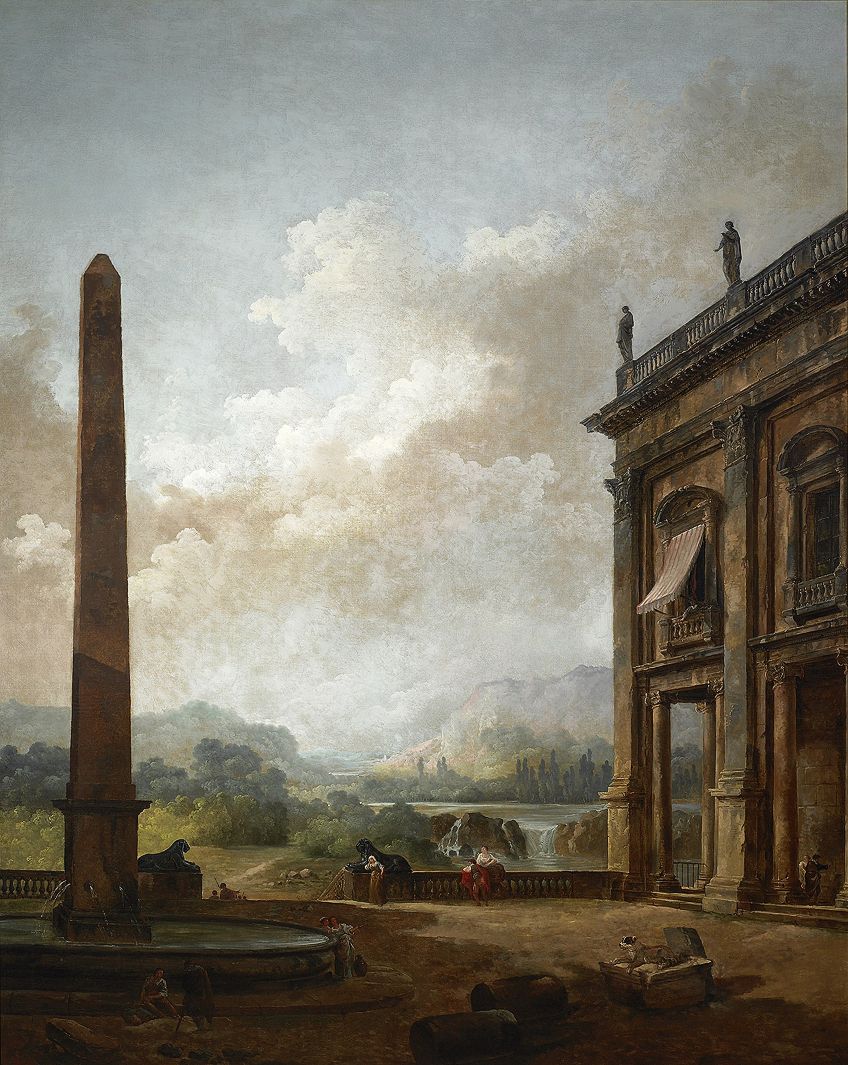
The Obelisk was originally meant to be displayed in the salon at the Château de Méréville and was painted in 1783. The painting is viewed from the perspective of being inside a great hall and looking out towards a scene that has been highly inspired by the architecture of ancient Rome, yet is another example of the style of combining real architecture and imagined places. This work features an obelisk placed in the middle of what could be a courtyard between buildings. The size of the interior of the temple looks huge when one takes into consideration the size of the people he has painted.
Although the scene may be a fabricated one, the style of the buildings is undoubtedly Roman in design and aesthetic.
Nero’s Torches (1876) by Henryk Siemiradzki
| Artist | Henryk Siemiradzki |
| Year | 1876 |
| Medium | Oil on Canvas |
| Location | National Museum, Kraków |
Henryk Hektor Siemiradzki was a Polish Academic artist, born in 1843, who was based in Romee. He was particularly regarded for his paintings of ancient Rome and Greece as well as his artistic depictions of biblical scenes from the New Testament. Henryk started studying at the Imperial Academy of Arts based in Saint Petersburg after graduating with a degree in the sciences at University. He then moved to Rome in 1872, opening a studio in Via Gaeta.
Also known as “Candlesticks of Christianity”, Henryk Siemiradzki painted “Nero’s Torches” in 1876, four years after building his studio in Via Gaeta.
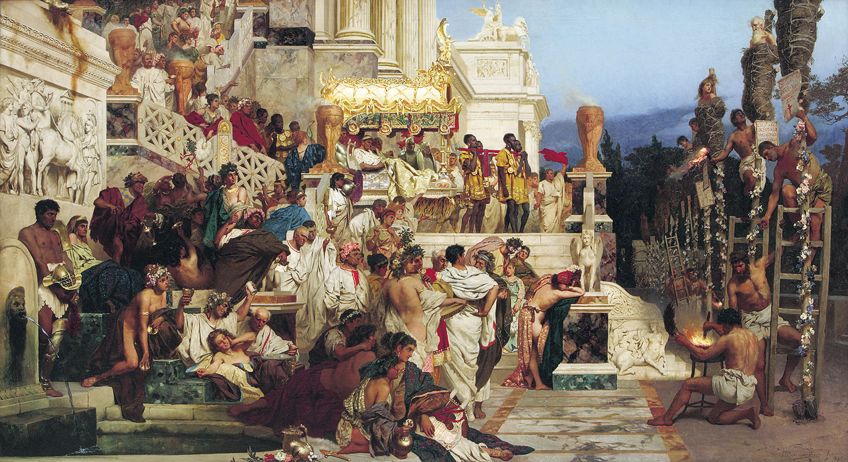
The painting portrays a scene where a group of Christians is about to be burned alive after being convicted for causing the Great Fire of Rome. The burning, which was to take place in front of the Domus Aurea, was attended by people from many different social classes, including Nero himself, the Emperor in 64 AD. After its first exhibition at the Accademia di San Luca in Rome in 1876, the painting then went on to tour European cities such as Prague, Berline, Vienna, Lviv, Munich, London, and Paris. Masters of art academia gave it positive reviews and it was met with much critical approval.
Very few Roman paintings still exist today compared to the recorded amount that is supposed to exist from ancient records. Many Roman statues and buildings are still to be found in their multitudes, but paintings from Rome are very rare. Thankfully, from the Roman frescos and Pompeii wall paintings, we have been able to catch a glimpse of the life and times of the Romans, visually encaptured.
https://www.youtube.com/watch?v=ELYoWlozNcc
Take a look at our famous Roman paintings webstory here!
Frequently Asked Questions
Where Can the Best Examples of Wall Paintings Be Found in Ancient Rome Today?
Almost two thousand years ago, the city of Pompeii was buried due to the eruption of Mount Vesuvius, leaving behind a picture of ancient Rome encased in time. Many of the artworks here have been greatly preserved, giving us greatly detailed insight into the lives and beliefs of those who lived there. One of the reasons the Pompeii wall paintings are so well preserved was due to the painting techniques used by the artists. Before painting on the surfaces, artists used to apply a layer of limestone plaster. This would be painted on while it was still wet, and in this manner, it helped seal the paint to the surface.
Does Roman Art Only Come From Rome itself?
Ancient Rome was very large, with the Roman Empire stretching over huge swathes of Europe. Thus, Roman artwork was usually influenced by other neighboring cultures such as the earlier Greek culture, and in return had a massive influence on the regions it occupied. Today, we can still find many exquisite examples of Roman drawings, paintings, and Roman fresco art in museums across Italy and other parts of Europe.
Isabella studied at the University of Cape Town in South Africa and graduated with a Bachelor of Arts majoring in English Literature & Language and Psychology. Throughout her undergraduate years, she took Art History as an additional subject and absolutely loved it. Building on from her art history knowledge that began in high school, art has always been a particular area of fascination for her. From learning about artworks previously unknown to her, or sharpening her existing understanding of specific works, the ability to continue learning within this interesting sphere excites her greatly.
Her focal points of interest in art history encompass profiling specific artists and art movements, as it is these areas where she is able to really dig deep into the rich narrative of the art world. Additionally, she particularly enjoys exploring the different artistic styles of the 20th century, as well as the important impact that female artists have had on the development of art history.
Learn more about Isabella Meyer and the Art in Context Team.
Cite this Article
Isabella, Meyer, “Roman Paintings – Exploring the Various Paintings of Ancient Rome.” Art in Context. September 2, 2021. URL: https://artincontext.org/roman-paintings/
Meyer, I. (2021, 2 September). Roman Paintings – Exploring the Various Paintings of Ancient Rome. Art in Context. https://artincontext.org/roman-paintings/
Meyer, Isabella. “Roman Paintings – Exploring the Various Paintings of Ancient Rome.” Art in Context, September 2, 2021. https://artincontext.org/roman-paintings/.





